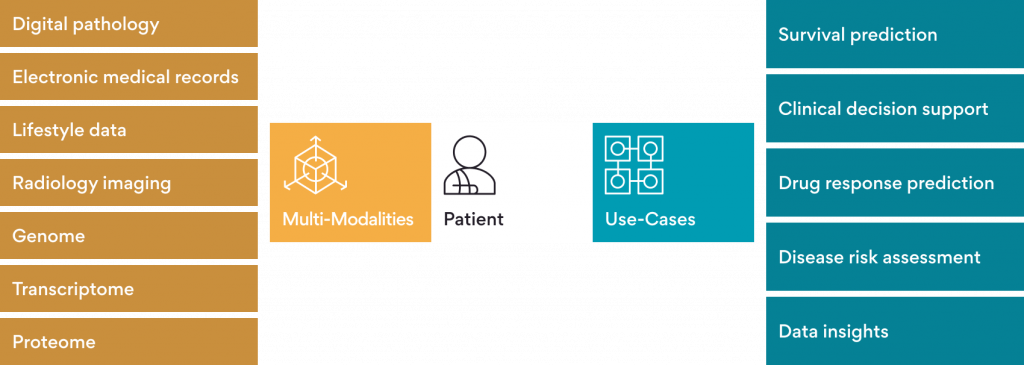Translational research is undergoing a remarkable transformation fueled by the integration of multi-modal data and its analysis. This revolutionary approach combines diverse datasets such as genomics, clinical records, images and various other modalities of patients’ data, enabling a comprehensive understanding of disorders such as cancer. This article explores the ground-breaking impact of multi-modal data analysis on cancer model development and its significance for a wide range of audience.
Genomics data provides valuable insights into the genetic makeup of cancer cells. By analyzing DNA sequencing and gene expression profiles, researchers, translational scientists and clinicians can identify genetic mutations, aberrant signaling pathways and potential therapeutic targets.
Clinical data encompasses a wide range of patient information, including medical histories, demographics, treatment records, survival and laboratory results. Integrating clinical data with genomics information allows researchers to uncover correlations between genetic alterations and clinical outcomes.
Medical imaging plays a pivotal role in cancer diagnosis, staging and monitoring. Images such as CT scans provide detailed cross-sectional images that help visualize tumor characteristics and guide treatment decisions.
Integrating multi-modal data such as genomics, clinical, and imaging data is a game-changer in cancer research. This approach enables the identification of complex associations and patterns that would have been overlooked when analyzing each data type in isolation. This presents an exciting opportunity for IT and technology companies to develop innovative data integration platforms, interoperable systems, advanced AI-based analytics, and visualization tools that enable seamless integration, analysis, and visualization of multi-modal data. By collaborating with experts in genomics, clinical research and medical imaging, IT and technology companies can drive the development of comprehensive cancer models and precision medicine approaches.

Multi-modal Data Analysis on Different Hyperscalers
Leading Hyperscalers like Amazon AWS, Microsoft Azure, and Google Cloud, provide machine learning-based services to build multi-modal data models for different use cases. Figs. 2, 3 and 4 below show the potential services/solutions and the tools available with the cloud providers for building and deploying data models.



Use cases and benefits of multi-modal data integration
Here are some use cases that highlight the potential of multi-modal data analysis in the healthcare and life sciences space:
- Predict cancer survival status using multi-modal data: Sagemaker-Jumpstart solution uses multi-modalities like Genomics, Clinical and Medical imaging to predict the survival of Non-Small Cell Lung Cancer (NSCLC) patients. Genomics data includes gene expression for a set of patients. Clinical data includes age, sex, clinical condition, family history and other lifestyle and phenotypic information. Image data considered here are 2D images of the CT scans performed before surgery, which are converted into 3D for feature extraction. Dimensionality reduction is performed to identify important features. Selected features are being used to train the prediction model. Model generated through this step can be used via Endpoints for a new set of patient data and a new multi-modal model can also be built utilizing the AWS-Sagemaker pipeline.
- Disease diagnosis and treatment: By integrating genomics, clinical records, and medical imaging data, multi-modal analysis can assist in predicting disease diagnosis, prognosis, and treatment response. This approach enables a comprehensive understanding of the disease, aiding healthcare professionals in making informed decisions about personalized treatment plans.
- Disease risk assessment: Integrating genetic data, patient medical histories, and imaging data can help predict an individual’s risk of developing diseases such as ischemic heart disease using Radiomics and EMR/EHR data, coronary artery disease detection using Electrocardiogram, Clinical data, etc. and identify disease subgroup using Genetic, Clinical, Imaging and Demographic data.
Persistent’s Multi-modal Data Analysis Pipeline and Solution
We are in the process of developing an end – to – end solution which will help user to build and deploy any new model. This solution has multiple services such as data upload, feature extraction, feature optimization, model building and inferences. End user can call these services as per their requirements.

Pipeline has following components:
- Data upload: Users can upload gene expression, clinical data and CT scans.
- Feature extraction and filtering: Pre-processing and validation of each input data and feature dimension reduction using PCA.
- Survival/Risk Prediction: Pre-built survival models are used to predict the survival risk.
Leveraging this pipeline and solution, user can easily view, analyze and export the results.
Challenges and Future Perspective
The main challenge in multi-modal data analysis is handling diverse data from various sources, which may have different formats and levels of noise. Combining multiple data types can create complex, high-dimensional data that needs careful analysis to extract relevant information without overfitting. Moreover, conducting this analysis requires expertise in genomics, clinical research, medical imaging, and data science. To overcome these challenges, collaboration among researchers, data scientists, domain/medical experts, and technology developers is essential. Utilizing innovative approaches and advancements in machine learning and artificial intelligence can help unleash the full potential of multi-modal data analysis.
Looking into the future, technological advancements, such as improved data integration methods and more powerful computing capabilities, will likely address some of the challenges in multi-modal data analysis. We can expect the development of standardized data formats and interoperable systems, easing the integration and analysis of diverse modalities (datasets). Additionally, the growing emphasis on data sharing and open science initiatives through different consortia will foster greater collaboration and data accessibility, fueling further breakthroughs in the field of multi-modal data analysis and accelerating progress in cancer research and other areas of healthcare.
Life sciences and Healthcare experts at Persistent Systems can help you build multi-modal pipelines on local servers or on cloud. Persistent’s multi-cloud-based Multi-omics solution provides integration of a variety of omics data, features such as custom workflows, cloud operations, data management and data visualization. As an organization with extensive expertise in technology and biological data, we deliver purpose-built and tailored solutions that can improve the customer’s productivity.
To know more about our multi-modal data analysis offerings, please reach out to us.



